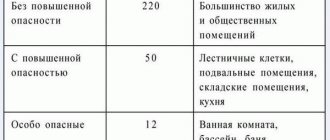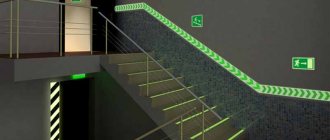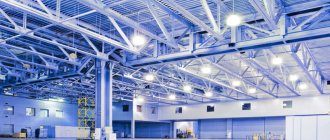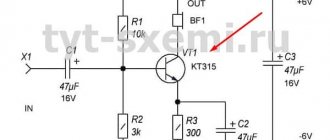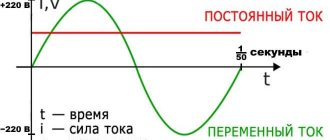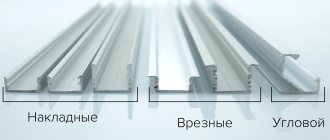Category of premises in 4. Categories of premises according to explosion or fire hazard, pue
Categories of premises according to explosion and fire hazard are a special division that is based on such an indicator as the fire load. In fact, this parameter is nothing more than the amount of thermal energy released when the room burns. That is, fire hazard categories are determined by the materials from which the building is constructed, materials stored in it in the form of finished products, or processed there.
It should be mentioned here that not only industrial buildings or warehouses are subject to fire load, this includes any premises where there is a high probability of fires. All this is recorded in the set of rules under number 12.13130.2009. In it, all buildings are divided into five categories, designated by the letters of the Russian alphabet from “A” to “D”. The premises were also divided into eight categories, in which the letter “B” is divided into four classes from B1 to B4.
Let us consider by what criteria the division occurs.
- Category "A". These are explosion- and fire-hazardous rooms or buildings in which explosive gases and liquids are used, as well as materials that can oxidize, ignite, or explode when interacting with water, air, or each other. There is an ignition temperature limit of +28C and an excess pressure of 0.05 bar. These parameters are critical for determining the category of buildings for explosion and fire safety.
- “B” category is also considered fire and explosion hazardous. Only for its determination are dusty media, flammable and combustible liquids that explode at a temperature of +28C and an excess pressure of 0.05 bar. Gases are not included in this category.
- "B1-B4". This is a fire hazardous category without explosions. This takes into account solid materials that can change their state of aggregation when interacting with water or air, forming a large number of suspended particles. The plug in this category takes into account the fire load acting on certain areas of the room, taking into account the type of placement.
- Category “G” are premises in which various materials with high temperatures are used, for example, in molten form, or liquid or gaseous fuel is used. There is a fairly wide range of premises from technological workshops to boiler rooms and other buildings for this purpose.
- “D” category of premises in which non-combustible materials are used or stored.
It is necessary to indicate that in the set of rules there are certain points that clarify the types of categorization of premises according to explosion or fire hazard:
- Category “A” may include objects, here we mean premises, compartments, the total area of which is not less than 5% of the total area of the building, or not less than 200 m².
- The same applies to premises falling under category “B”.
- With category “B” everything is not so simple. Here it is necessary to take into account the positions associated with the areas of the compartments. The basic principle of determination is based on the percentage ratio of areas A-B3, here the limit is more than 5% of the total area, or 10% if the building does not have compartments with categories A and B. There is another setting where a limit of 25% is taken into account. That is, if the compartments or premises are smaller in area than this percentage, but not more than 3500 m², then such premises do not belong to category “B”. This also applies to those compartments where an automatic fire extinguishing system is installed.
- The same can be said for the “G” category. If in a building the sum of areas falling under category A-G is more than 5%, then they can be classified in this fire hazard category. If the area is less than 25%, but not more than 5000 m², and the compartments of categories A-B3 are equipped with an automatic system, then they do not fall under the G-category.
- With “D” everything is simpler; premises fall under this category if they do not belong to the previous varieties.
It should also be added that the classification of premises for fire safety is also taking into account the rules of the PUE, that is, electrical safety, based on the competent operation of wiring and electrical equipment. According to the PUE, all rooms and compartments are divided into six explosion hazard zones and four fire hazard zones. The determination criteria are again the materials that are used inside.
In addition to materials for categorizing premises according to explosion and fire hazards, other factors are taken into account:
- area of the room or building;
- the volume of gas or liquids (a possible value is used here) that were released during the depressurization of equipment or pipelines;
- distribution of equipment (warehouse, technological, additional) across the compartment area.
Fire zones - classification
There is a classification of premises according to fire zones, where the designation is completely different - the letter “P”.
- The first zone, designated P-I, includes rooms where flammable gases that ignite at a temperature of +61C are used.
- Zone P-II is a room where dust or small fibers of various materials are present in the air. In this case, the particle concentration should be within 65 g/m³. This is the so-called explosive concentration.
- Zone P-IIa. In such premises, solid combustible materials are processed or stored, the specific load in terms of fire safety is within 1 MJ/m².
- P-III. These are zones located outside the premises. They contain solid combustible materials or gases of the same type. For the latter, the ignition temperature should be +61C.
Attention! If flammable substances are used indoors in the technological process, plus open fire is used, and the process equipment itself, in which all operations with flammable materials are carried out, is located at a distance of no more than 5 m from the boundaries of the zone, then such a zone cannot be considered a fire hazard.
Everything that is located outside the five-meter limit is classified as a fire hazard, taking into account technological processes. If one piece of equipment classified as a fire hazard is installed in the room, then the area within 3 m is considered dangerous. However, there is one condition - if fire hazard measures have not been developed inside the premises.
If premises are used for ventilation of zones P-II, that is, exhaust or supply fans are installed inside them, then they also belong to category P-II. If fans are mounted behind external fences, that is, rooms are not specially constructed for them, then their design must necessarily include materials corresponding to fire zone P-III.
Explosive areas - classification
There are eight positions here that differ significantly from each other.
| Class | Characteristic |
| Explosive mixtures of various gases are present in the premises: continuously or for 1 hour. | |
| 1 (BI) | There are vapors or gases that, when combined with air, form explosive mixtures. |
| 2 (BIa) | These mixtures do not form, but an explosion can occur in emergency situations involving process equipment. |
| 3 (VIb) | Here the requirements are the same as in the class above, but there are some nuances: · gases (flammable) should not have a concentration below 15%, there should be a strong odor in the premises; · if hydrogen is used in industrial premises, where the concentration is not lower than 0.75 m from the floor should be more than 5% of the total volume of the zone. |
| 4 (BIr) | This includes areas where outdoor installations with flammable liquids and gases have been installed: gas tanks, tanks, drain racks, oil traps and others. |
| 20 | Rooms with dust concentrations below 65 g/m³. This means constantly. |
| 21 (VII) | Such premises contain equipment that can emit dust and other suspended particles to explosive concentrations. |
| 22 (VIIa) | The same thing, only without the dust emitted by the equipment. But this can happen during an accident. |
Building categories
Explosion hazard classes of premises affect the category to which the entire building can be classified. Depending on the area of rooms with hazardous substances and their quantity, the following assessment is given to the entire property:
- A - assigned if the area of individual premises is 5% or more of the entire building, provided that it does not have automatic fire extinguishing systems. When they exist, such a class is awarded if there are 25% or more m2 falling under category A. Another criterion is the total space of such rooms from 200 m2 in the first case and from 1000 m2 in the second.
- B - this class is assigned when the total area of premises with categories A and B exceeds 5% (without automatic extinguishing systems) and 25% with automatic installations. The same standards for total area limits apply here as in category A.
- B - the area of premises of categories A, B, C exceeds 5% (or 10%, if only A and B). If there are automatic extinguishing systems, it is assigned when 3500 m2 is exceeded.
- D - the sum of the area of rooms with categories A, B, C and D more than 5%. If the building has a built-in automatic fire extinguishing system, then the number is considered to be 25% m2 of the total or 5000 m2 in total.
- D - all other buildings not included in categories A, B, C, D.
Determination of categories B1-B4 premises
| Determination of the categories of premises, buildings and external installations for explosion and fire hazard, as well as the class of the zone according to the PUE (Rules for the Construction of Electrical Installations), according to the set of rules SP 12.13130.2009 “Definition of categories of premises, buildings and external installations for explosion and fire hazard” (with Change No. 1). Categorization of premises according to the Electrical Installation Rules (abbreviated PUE) is required only for warehouse and production premises, including:
Determining the category of warehouse or production premises according to the PUE is necessary in order to subsequently select the correct electrical equipment for certain areas of the building. Who determines the explosion hazard class of indoor areas? Specialists from the design organization - a technologist or an electrical engineer - will help determine which category according to the PUE the premises belong to. First of all, the technician will determine the presence and number of different explosion and fire hazard zones in the room. The following criteria are taken into account:
Classification of explosion and fire hazardous zones and categorization of premises is carried out at the stage of development of project documentation, even before the start of construction work on the site. Classes of hazardous areas of premises according to PUE Based on whether a leak of an explosive mixture is possible during the operation of technological equipment, classes of explosive zones are identified in the room. They also take into account the likely duration and frequency of the presence of the mixture in the room, establishing 3 types of leakage depending on this: constant, 1st and 2nd degree. The explosion hazard zones in the room are classified as follows:
The Rules provide exceptions that are possible when defining hazardous areas. The PUE describes in detail each zone class, and also gives the classes of zones of premises adjacent to the explosive zone of another room. Classes of fire hazardous zones according to the PUE According to the risk of fire in different areas of the room, they are divided into 4 classes:
|
Regulatory documents for classification
In order to clearly determine which category certain premises and buildings belong to, two methods and documents regulating them have been developed. The deterministic method in the Russian Federation is regulated by NPB-105-03 and the “Rules for the construction of electrical installations” (PUE). The classification of explosive zones according to PUE and NPB-105-03 helps to divide production and warehouse buildings, as well as technical blocks into categories, which indicates subsequent planning or development by number of floors (in case of facility expansion), choice of materials and other equipment. The probabilistic method is formulated in GOST 12.1.004-91 and implies taking into account the acceptable risk, the probability of a fire and the totality of hazardous factors in each specific room.
Explosion and fire hazard category and its definition
/ Articles / Fire safety / Fire safety on site
It is always interesting to know what is behind the closed, unmarked door of a building or room. But, basically, everyone who has left a tender age and knows that Buki is not in this world, guesses that a very real, uncontrived danger may await a careless, unprepared visitor there.
No, we are not talking about traps set for uninvited guests, but about radiation, a poisonous, chemically aggressive, biologically active, explosive and fire hazardous air environment, which is not uncommon not only for premises and/or buildings of industrial enterprises; but also for public facilities for various purposes, where there is always a place for placing/storing technological and engineering equipment, raw materials, commercial products, substances/materials that pose a threat to the health and lives of people.
Due to the fact that possible explosions and fires are a sad, but technologically designed reality, included in the plans for emergency response and evacuation of people at most chemical, oil and gas enterprises, and other industries where flammable substances are stored, processed and pumped in all aggregates states; The state has developed regulatory requirements that determine what the category of a building is in terms of explosion and/fire hazard.
Maybe
The need for classification by attitude
Since electrical equipment is used in most premises in enterprises, the degree of spread of the fire and the difficulty of extinguishing it depend on the strength of its housing and frame. For example, a machine that uses oil for lubrication can still burn for a long time, although there is only metal around it. In this regard, they developed “Rules for the Construction of Electrical Installations” (PUE), regulating the level of protection of equipment used depending on the explosion hazard class of industrial premises.
Another standard here is GOST R 51330.9-99, which evaluates the quantitative influence of various factors on the area (presence of explosive mixtures, ventilation, current, frequency of presence of hazardous substances in a particular place). Depending on this, 1st class or 2nd class is awarded. The degree of probable leakage, its duration and interaction with surrounding materials are also taken into account. Class 3 is not used in the system, but is replaced by more expanded divisions (classes 20, 21, 22).
Classification of zones according to PUE
The explosion hazard class according to the PUE helps to select the correct level of equipment protection, which reduces the overall likelihood of a fire or explosion. It is assigned based on the following characteristics:
- 0—equipment operates continuously or for more than an hour using explosive gas.
- Class 1 - also designated as BI, the installations operate as usual and emit their own flammable gases or technical liquids that can spontaneously ignite from the air.
- Class 2 - prescribed as B-Ia, and refers to areas where the release of explosive substances is possible only in the event of equipment breakdown or accident. It may have clarifying classes B-Ib - gases with a flammability limit of 15% or higher, which have a pungent odor for detecting leaks (ammonia, etc.). B-Ig - zones inside which there are oil films and other flammable liquids in an open form (filling and draining oils, oil traps, settling tanks). The size of the zone extends up to 20 m from the place where the flammable liquid is open.
- Class 20 - constant presence of substances with a lower flammability limit of 65 g/m3 and below.
- Class 21 - designated as B-II. Release of flammable vapors and liquids during equipment operation, with a concentration of 65 g/m3.
- Class 22 - also found as B-IIa. Formation of an explosive cloud with a concentration limit of 65 g/m3 by working units as a result of an accident.
The classification of fire and explosion hazardous areas, and the specific explosion hazard class in each case is taken into account when designing systems for preventing fires, warning personnel, organizing evacuation and equipping places with extinguishing means. TRIO is an expert in this field, and we are ready to survey any property and help assign the correct class to each room, building and area. All work is accompanied by documentation ensuring the passage of inspections by regulatory authorities. We provide a full range of services to ensure fire safety at the facility.

